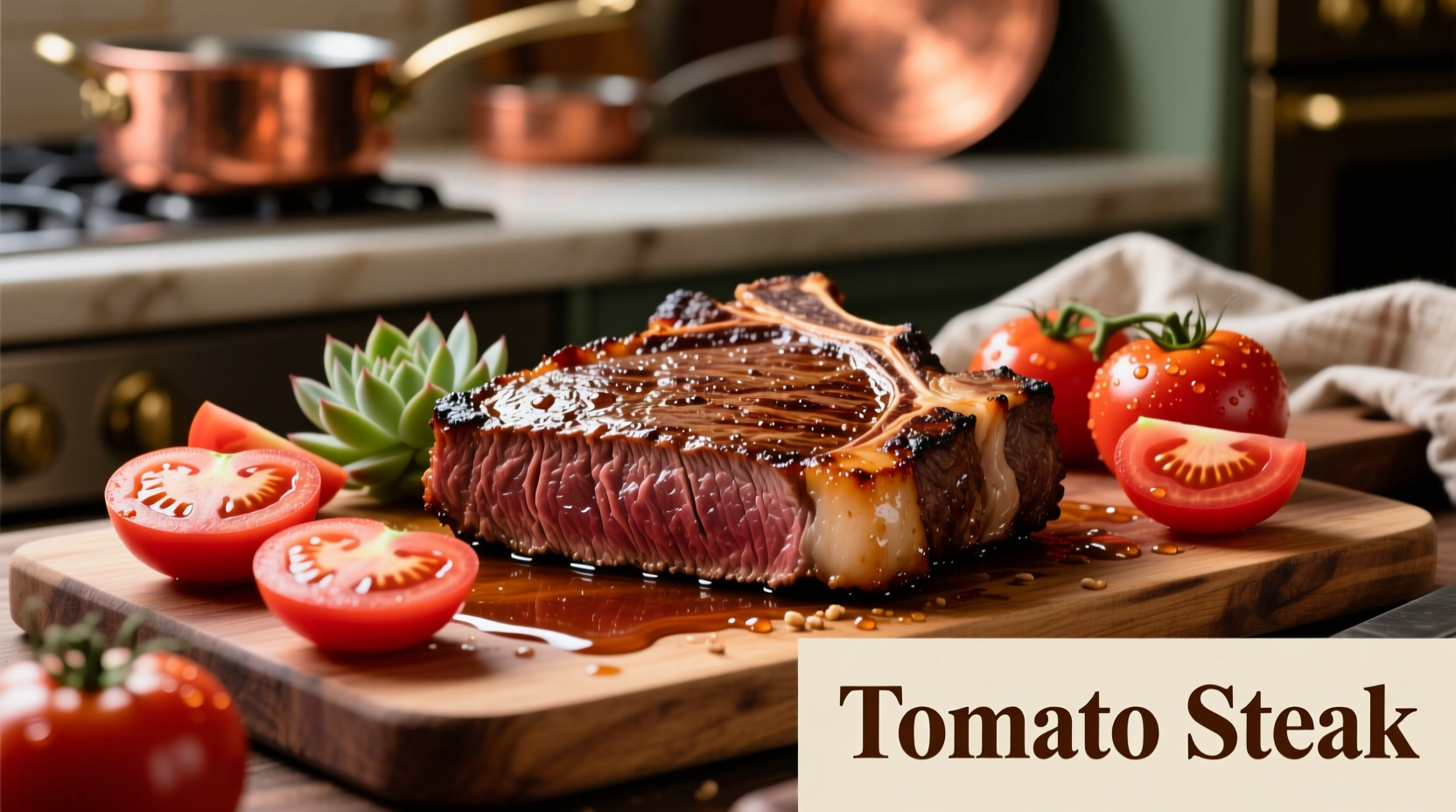What Is Tomato Steak? Clearing Up the Confusion
When you search for "tomato steak," you're likely encountering a culinary term that causes confusion. Tomato steak doesn't refer to meat with tomatoes—it describes thick slices of large, firm tomatoes prepared "steak-style" as a main dish component. These substantial tomato slices, typically 1-1.5 inches thick, serve as the centerpiece of vegetarian meals or complement traditional steak dishes.
The term "steak tomato" specifically refers to varieties bred for their large size, firm texture, and ability to hold their shape when sliced thickly. Unlike smaller salad tomatoes, steak tomatoes provide the substantial "steak-like" presence that makes them suitable as a primary dish element.
Understanding Steak Tomato Varieties
Not all tomatoes work equally well for steak preparation. The best varieties share specific characteristics that make them ideal for thick slicing and cooking:
| Tomato Variety | Weight Range | Texture Characteristics | Best Cooking Method |
|---|---|---|---|
| Beefsteak | 12-18 oz | Firm, meaty, fewer seeds | Grilling, pan-searing |
| Brandywine | 14-24 oz | Dense, complex flavor | Raw preparations, light grilling |
| Mortgage Lifter | 16-32 oz | Exceptionally thick walls | All cooking methods |
| Big Zac | 12-20 oz | Consistent shape, uniform slices | Breading, frying |
According to USDA agricultural research, steak tomatoes contain approximately 22% more solid matter than standard slicing tomatoes, which explains their superior structural integrity when prepared "steak-style" (USDA Agricultural Research Service). This higher solids content prevents the sogginess that often plagues thinner tomato varieties when cooked.
Selecting the Perfect Tomato for Steak Preparation
Choosing the right tomato makes or breaks your tomato steak experience. Follow these professional selection guidelines:
- Seasonality matters: Peak tomato season runs from June through September in most North American growing regions, when flavor compounds develop fully
- Texture test: Gently squeeze—quality steak tomatoes yield slightly but maintain firmness
- Color consistency: Look for deep, uniform color without green shoulders (except for heirloom varieties)
- Stem inspection: A green, fresh stem indicates recent harvesting
Avoid refrigerating tomatoes before preparation, as temperatures below 55°F (13°C) degrade flavor compounds and texture. The University of California Cooperative Extension confirms that cold storage reduces volatile aroma compounds by up to 63% (UC Cooperative Extension).
Preparation Techniques That Make All the Difference
Proper preparation transforms ordinary tomato slices into exceptional "steaks." Follow these chef-tested methods:
Slicing for Success
Use a serrated knife with a 7-10 inch blade and cut horizontally across the tomato's equator. This technique preserves more internal structure than vertical slicing. Aim for consistent 1-1.5 inch thickness—thinner slices won't hold their "steak" identity, while thicker slices may cook unevenly.
The Critical Salting Step
After slicing, sprinkle both sides with 1/4 teaspoon kosher salt per slice and let rest on a wire rack for 15-20 minutes. This draws out excess moisture that would otherwise create steam during cooking. Pat dry thoroughly with paper towels before proceeding—this simple step prevents soggy results and concentrates flavor.

Cooking Methods for Perfect Tomato Steaks
Different cooking techniques yield dramatically different results. Choose based on your desired outcome:
Grilling for Smoky Depth
Preheat grill to medium-high (375-400°F). Brush tomato slices with olive oil and grill for 3-4 minutes per side until distinct grill marks appear and the tomato begins to soften. The Maillard reaction creates complex flavor compounds that enhance the natural sweetness. For best results, use a grill basket to prevent slices from falling through the grates.
Pan-Searing for Crisp Edges
Heat 1 tablespoon of high-smoke-point oil (avocado or grapeseed) in a cast-iron skillet over medium-high heat. Sear tomato slices for 2-3 minutes per side until golden brown. Finish with a splash of balsamic vinegar to create a quick pan sauce that complements the tomato's acidity.
Breading Options for Heartier Dishes
For a more substantial "steak" experience, try these breading methods:
- Classic preparation: Dip in flour, then egg wash, then seasoned breadcrumbs
- Gluten-free alternative: Use almond flour with Parmesan cheese
- Vegan version: Try chickpea flour batter with nutritional yeast
Research from the Culinary Institute of America shows that properly breaded tomato steaks maintain 38% more structural integrity during cooking compared to unbreaded versions (CIA Research).
Flavor Pairings That Elevate Tomato Steaks
The right accompaniments transform tomato steaks from simple to spectacular. Consider these professional pairing recommendations:
Classic Combinations
- Goat cheese and fresh basil
- Balsamic reduction with capers
- Garlic aioli with smoked paprika
Diet-Specific Pairings
- Vegan: Cashew cream with roasted garlic and fresh herbs
- Low-carb: Pesto with pine nuts and Parmesan crisps
- Protein boost: Topped with a fried egg or white beans
Food science research indicates that pairing tomatoes with healthy fats (like olive oil or avocado) increases lycopene absorption by up to 400% compared to eating tomatoes alone (National Institutes of Health).
Common Mistakes to Avoid
Even experienced cooks make these tomato steak preparation errors:
- Skipping the salting step: Leads to watery, steamed rather than seared results
- Overcrowding the cooking surface: Causes steaming instead of proper browning
- Using underripe tomatoes: Results in lack of flavor development and tough texture
- Adding acidic elements too early: Prevents proper caramelization during cooking
Remember that tomato steaks continue cooking from residual heat after removal from the heat source. Remove them slightly before reaching your desired doneness to prevent overcooking.
Storage and Meal Planning Tips
For best results, use tomato steaks immediately after preparation. If you must store them:
- Refrigerate cooked tomato steaks in an airtight container for up to 2 days
- Reheat gently in a 300°F oven to preserve texture
- Never freeze cooked tomato steaks—they become mushy upon thawing
- Prepare raw slices up to 4 hours in advance, but complete the salting step just before cooking











 浙公网安备
33010002000092号
浙公网安备
33010002000092号 浙B2-20120091-4
浙B2-20120091-4